The Effect of Recycled Crushed Brick Aggregate on the Physical–Mechanical Properties of Earth Blocks
Abstract
1. Introduction
1.1. Study of Physical–Mechanical Properties in EB
1.2. Incorporation of CCB in Eb Manufacturing
2. Materials
2.1. Soil
2.2. CCB Aggregates
2.3. Water
3. Methods
3.1. Characterization of Aggregates
3.2. Manufacturing
3.3. Experimental Evaluation
3.3.1. Test to Determine Apparent Density and Porosity
3.3.2. Method for Hygroscopic Expansion Test
3.3.3. Method for Compressive Strength Test
3.3.4. Method for Three-Point Bending Test
3.3.5. Method for Ultrasound Analysis Test
3.3.6. Method for TGA Test
4. Results and Discussion
4.1. Characterization Results
4.2. Density and Apparent Porosity
4.3. Hygroscopic Expansion Test Results
4.4. Compressive Strength Test Results
4.5. Three-Point Bending Test Results
4.6. Ultrasound Analysis Test Results
4.7. TGA Test Results
4.8. Microstructural Study of the Constituent Matrices
4.9. Environmental Considerations
5. Conclusions
Author Contributions
Funding
Data Availability Statement
Acknowledgments
Conflicts of Interest
Acronyms/Abbreviations/Initialisms
| CBW | Ceramic brick waste |
| CCB | Crushed ceramic brick |
| CCBs | Crushed ceramic bricks |
| CDW | Construction demolition waste |
| CEB | Compressed earth block |
| CEBs | Compressed earth blocks |
| CI | Confidence interval |
| DS | Differential stages |
| dTGA | Derived from thermogravimetric analysis |
| E | Soil |
| EB | Earth block |
| EBs | Earth blocks |
| FM | Fineness modulus |
| HC | Moisture content |
| IQR | Interquartile Range |
| ITZ | Interstitial transition zone |
| LL | Liquid limit |
| OIA | Optical Image Analysis |
| P | Peak |
| PL | Plastic limit |
| RCA | Recycled construction aggregate |
| RCAs | Recycled construction aggregates |
| RH | Relative humidity |
| RD | Royal decree |
| S | Slope |
| SEB | Stabilized earth block |
| SEBs | Stabilized earth blocks |
| SPSS | Statistical Software Package for Social Sciences |
| T | Temperature |
| TGA | Thermogravimetric analysis |
| TMLA | Total mass loss area |
| TR | Temperature range |
| UPV | Ultrasonic pulse velocity |
| W | Weight |
| Symbols: | |
| Δx | Longitudinal dimensional variation |
| Φ | Diameter |
| E∂ | Young’s modulus |
| fc | Compressive strength |
| fb | Bending strength |
| fbt | Flexo-traction |
| σ | Standard deviation |
| μ | Poisson coefficient |
| Others: | |
| ASTM | American Society for Testing and Material Standards |
| BTC2 | Classification for Type 2 earth blocks according to their compressive strength, determined by UNE 41410 standard |
| BTC3 | Classification for Type 3 earth blocks according to their compressive strength, determined by the UNE 41410 standard |
| INE | National Institute of Statistics of Spain |
| ISO | International Organization for Standardization |
| E-080 | Peruvian standard for design and construction with reinforced earth |
| UNE | Una Spanish Standard Norm |
References
- Jaquin, P.A.; Augarde, C.E. Earth Building: History, Science and Conservation. Dec. [Online]. 2012. Available online: https://durham-repository.worktribe.com/output/1124958 (accessed on 13 December 2024).
- Pacheco-Torgal, F. 1—Introduction to eco-efficient masonry bricks and blocks. In Eco-Efficient Masonry Bricks and Blocks; Pacheco-Torgal, F., Lourenço, P.B., Labrincha, J.A., Kumar, S., Chindaprasirt, P., Eds.; Woodhead Publishing: Oxford, UK, 2015; pp. 1–10. [Google Scholar] [CrossRef]
- Viñuales, G.M. Tecnología y construcción con tierra. Apunt. Rev. Estud. Sobre Patrim. Cult.—J. Cult. Herit. Stud. 2007, 20, 220–231. [Google Scholar]
- Simões, G.M.F.; Labaki, L.C. Thermal discomfort and adaptation strategies in Brazilian social housing. Build. Environ. 2025, 269, 112368. [Google Scholar] [CrossRef]
- Ogu, V.I. Rural housing quality in Nigeria: A case study from Imo State. Habitat Int. 1994, 18, 53–65. [Google Scholar] [CrossRef]
- Mamani, G.M.; Cahuapaza, Y.R.E.; García, A.J.M.; Asencio, S.F.; Mamani, V.E. Evaluation of thermal insulation in rural dwellings for their natural bioclimatic conditioning at 3820 m.a.s.l. SciELO Prepr. 2023. [Google Scholar] [CrossRef]
- Taallah, B.; Guettala, A.; Guettala, S.; Kriker, A. Mechanical properties and hygroscopicity behavior of compressed earth block filled by date palm fibers. Constr. Build. Mater. 2014, 59, 161–168. [Google Scholar] [CrossRef]
- Haddad, K.; Lannon, S.; Latif, E. Investigation of Cob construction: Review of mix designs, structural characteristics, and hygrothermal behaviour. J. Build. Eng. 2024, 87, 108959. [Google Scholar] [CrossRef]
- Bamogo, H.; Ouedraogo, M.; Sanou, I.; Ouedraogo, K.; Kalifa, D.; Aubert, J.; Millogo, Y. Improvement of water resistance and thermal comfort of earth renders by cow dung: An ancestral practice of Burkina Faso. J. Cult. Herit. 2020, 46, 42–51. [Google Scholar] [CrossRef]
- Cagnon, H.; Aubert, J.; Coutand, S.; Magniont, C. Hygrothermal properties of earth bricks. Energy Build. 2014, 80, 208–217. [Google Scholar] [CrossRef]
- Lahbabi, S.; Bouferra, R.; Saadi, L.; Khalil, A. Study of the physicochemical, mineralogical, and geotechnical properties of clayey soils to improve the durability of eco-construction materials in the rural region. Constr. Build. Mater. 2024, 411, 134304. [Google Scholar] [CrossRef]
- Miccoli, L.; Müller, U.; Fontana, P. Mechanical behaviour of earthen materials: A comparison between earth block masonry, rammed earth and cob. Constr. Build. Mater. 2014, 61, 327–339. [Google Scholar] [CrossRef]
- Charai, M.; Salhi, M.; Horma, O.; Mezrhab, A.; Karkri, M.; Amraqui, S. Thermal and mechanical characterization of adobes bio-sourced with Pennisetum setaceum fibers and an application for modern buildings. Constr. Build. Mater. 2022, 326, 126809. [Google Scholar] [CrossRef]
- Wakil, M.; El Mghari, H.; Kaitouni, S.I.; El Amraoui, R. Thermal energy performance of compressed earth building in two different cities in Moroccan semi-arid climate. Energy Built Environ. 2024, 5, 800–816. [Google Scholar] [CrossRef]
- Papayianni, I. Earth Block Houses of Historic Centers. A Sustainable Upgrading with Compatible Repair Materials. Procedia Environ. Sci. 2017, 38, 274–282. [Google Scholar] [CrossRef]
- Wang, C.; Xiao, J.; Zhang, G.; Li, L. Interfacial Properties of Modeled Recycled Aggregate Concrete Modified by Carbonation. Constr. Build. Mater. 2016, 105, 307–320. [Google Scholar] [CrossRef]
- Bao, Z. Applicability of the environmental Kuznets curve to construction waste management: A panel analysis of 27 European economies. Resour. Conserv. Recycl. 2023, 188, 106667. [Google Scholar] [CrossRef]
- Min, V.; Panuwatwanich, K. Enhancing performance of construction waste management: Factor analysis from the building contractors’ perspectives. Clean. Waste Syst. 2024, 9, 100176. [Google Scholar] [CrossRef]
- Ahmed, J.K.; Atmaca, N.; Khoshnaw, G.J. Building a Sustainable Future: An Experimental Study on Recycled Brick Waste Powder in Engineered Geopolymer Composites. Case Stud. Constr. Mater. 2024, 20, e02863. [Google Scholar] [CrossRef]
- Junior, A.C.; Teixeira, E.; Mateus, R. Improving the mechanical, thermal and durability properties of compressed earth blocks by incorporating industrial waste and by-products: A systematic literature review. Constr. Build. Mater. 2024, 438, 137063. [Google Scholar] [CrossRef]
- National Extraction by Type of Indicator and Years. INE. [Online]. Available online: https://www.ine.es/jaxi/Datos.htm?path=/t26/p086/serie/l0/&file=02001.px (accessed on 27 January 2023).
- Soibelman, L. Material de Desperdicio en la Industria de la Construcción: Incidencia y Control; Cuadernos FICA: Champaign, IL, USA, 2000. [Google Scholar]
- Rigassi, V. Compressed Earth Blocks: Manual of Production; Deutsches Zentrum fur Entwicklungstechnologien, GATEBASIN: Berlin, Germany, 1985. [Google Scholar]
- Fernandes, J.; Peixoto, M.; Mateus, R.; Gervásio, H. Life cycle analysis of environmental impacts of earthen materials in the Portuguese context: Rammed earth and compressed earth blocks. J. Clean. Prod. 2019, 241, 118286. [Google Scholar] [CrossRef]
- Widera, B. Comparative analysis of user comfort and thermal performance of six types of vernacular dwellings as the first step towards climate resilient, sustainable and bioclimatic architecture in western sub-Saharan Africa. Renew. Sustain. Energy Rev. 2021, 140, 110736. [Google Scholar] [CrossRef]
- Basta, A.H.; Lotfy, V.F.; Shafik, E.S. Synergistic valorization of rice straw and red brick demolition in development performance of lightweight cement mortars. J. Build. Eng. 2024, 92, 109769. [Google Scholar] [CrossRef]
- Sathiparan, N. Performance of sustainable cement mortar containing different types of masonry construction and demolition wastes. Clean Technol. Environ. Policy 2024, 26, 1861–1881. [Google Scholar] [CrossRef]
- Lutfi, M.A.; Dawood, E.T.; Al-Busaltan, S. Evaluating Waste Brick powder incorporation on Mortar properties. AIP Conf. Proc. 2023, 2862, 020004. [Google Scholar] [CrossRef]
- Ghrieb, A.; Abadou, Y.; Bustamante, R.; de Rojas, M.I.S. Investigation of the pore structure performance of dune sand mortar with ceramic waste. Proc. Inst. Civ. Eng.-Eng. Sustain. 2023, 177, 284–298. [Google Scholar] [CrossRef]
- Borçato, A.G.; Thiesen, M.; Medeiros-Junior, R.A. Incorporation of clay brick wastes and calcium hydroxide into geopolymers: Compressive strength, microstructure, and efflorescence. J. Build. Eng. 2024, 88, 109259. [Google Scholar] [CrossRef]
- İlcan, H.; Külak, A.Y.; Şahmaran, M. 3D-printable construction and demolition waste-based geopolymer: Investigating the effects of additives on engineering properties. J. Build. Eng. 2024, 87, 109094. [Google Scholar] [CrossRef]
- Gaddam, A.G.; Gondu, V.R.; Yamsani, S.K.; Adigopula, V.K. Comprehensive utilization of brick waste as a precursor in synthesizing geopolymer for treating black cotton soil. Int. J. Geotech. Eng. 2023, 18, 360–366. [Google Scholar] [CrossRef]
- Haq, M.A.U.; Xia, P.; Khan, S.; Hassam, M.; Sohaib, M.; Gong, F. Optimal utilization of low-quality construction waste and industrial byproducts in sustainable recycled concrete. Constr. Build. Mater. 2024, 428, 136362. [Google Scholar] [CrossRef]
- Mangngi, P.; Tjaronge, M.W.; Caronge, M.A. Durability assessment of concrete containing recycled coarse refractory brick aggregate. Innov. Infrastruct. Solut. 2024, 9, 144. [Google Scholar] [CrossRef]
- Nasr, M.; Salman, A.; Ghayyib, R.; Shubbar, A.; Al-Mamoori, S.; Al-Khafaji, Z.; Hashim, T.; Hasan, Z.; Sadique, M. Effect of Clay Brick Waste Powder on the Fresh and Hardened Properties of Self-Compacting Concrete: State-of-the-Art and Life Cycle Assessment. Energies 2023, 16, 12. [Google Scholar] [CrossRef]
- Ghosh, S. Utilization of recycled refractory brick as fine aggregate on various properties of sustainable concrete. Mater. Today Proc. 2023, in press. [CrossRef]
- Quispe, E.H.; Salvador, C.G.R.; Aranda, J.J.M.; Montoya, N.I.V.; Morejón, I.Y.P. Improvement of Bearing Capacity with Cement, Lime and Brick Waste in Soft Soils for Foundation Purposes. Civil. Eng. Archit. 2024, 12, 97–108. [Google Scholar] [CrossRef]
- Labiad, Y.; Meddah, A.; Beddar, M. Performance of sisal fiber-reinforced cement-stabilized compressed-earth blocks incorporating recycled brick waste. Innov. Infrastruct. Solut. 2023, 8, 107. [Google Scholar] [CrossRef]
- Kasinikota, P. Predicting the effect of crushed brick particle size on anisotropy, physical and mechanical properties of compressed stabilized earth blocks using ultrasonic pulse velocity. Mater. Struct. 2021, 54, 112. [Google Scholar] [CrossRef]
- Kasinikota, P. Evaluation of compressed stabilized earth block properties using crushed brick waste. Constr. Build. Mater. 2021, 280, 122520. [Google Scholar] [CrossRef]
- Minke, G. Building with Earth: Design and Technology of a Sustainable Architecture, 2nd and rev. ed.; Birkhäuser: Basel, Switzerland; Berlin, Germany; Boston, MA, USA, 2006. [Google Scholar]
- Martínez, P.S.; Cortina, M.G.; Martínez, F.F.; Sánchez, A.R. Comparative study of three types of fine recycled aggregates from construction and demolition waste (CDW), and their use in masonry mortar fabrication. J. Clean. Prod. 2016, 118, 162–169. [Google Scholar] [CrossRef]
- Panizza, M.; Natali, M.; Garbin, E.; Ducman, V.; Tamburini, S. Optimization and mechanical-physical characterization of geopolymers with Construction and Demolition Waste (CDW) aggregates for construction products. Constr. Build. Mater. 2020, 264, 120158. [Google Scholar] [CrossRef]
- Turco, C.; Junior, A.C.P.; Teixeira, E.R.; Mateus, R. Optimisation of Compressed Earth Blocks (CEBs) using natural origin materials: A systematic literature review. Constr. Build. Mater. 2021, 309, 125140. [Google Scholar] [CrossRef]
- Latha, A.T.; Murugesan, B.; Kabeer, K.I.S.A. Valorisation of municipal solid waste incinerator bottom ash for the production of compressed stabilised earth blocks. Constr. Build. Mater. 2024, 423, 135827. [Google Scholar] [CrossRef]
- Aninda, S.S. Effectiveness of waste concrete powder in fabricating compressed stabilized earth blocks: Strength, durability and thermal assessment. J. Build. Eng. 2023, 80, 107989. [Google Scholar] [CrossRef]
- Kongkajun, N.; Laitila, E.A.; Ineure, P.; Prakaypan, W.; Cherdhirunkorn, B.; Chakartnarodom, P. Soil-cement bricks produced from local clay brick waste and soft sludge from fiber cement production. Case Stud. Constr. Mater. 2020, 13, e00448. [Google Scholar] [CrossRef]
- Normas del Reglamento Nacional de Edificaciones (RNE). [Online]. Available online: https://www.gob.pe/institucion/sencico/informes-publicaciones/887225-normas-del-reglamento-nacional-de-edificaciones-rne (accessed on 21 October 2024).
- Standard Terminology Relating to Concrete and Concrete Aggregates. [Online]. Available online: https://www.astm.org/c0125-03.html (accessed on 13 December 2024).
- Standard Practice for Classification of Soils for Engineering Purposes (Unified Soil Classification System). [Online]. Available online: https://www.astm.org/d2487-17.html (accessed on 4 July 2024).
- UNE 41410:2023; Bloques de Tierra Comprimida (BTC) Para Muros y Tabiques. UNE: Madrid, Spain, 2023. Available online: https://www.une.org/encuentra-tu-norma/busca-tu-norma/norma?c=N0072146 (accessed on 4 July 2024).
- Standard Test Methods for Liquid Limit, Plastic Limit, and Plasticity Index of Soils. [Online]. Available online: https://www.astm.org/d4318-17e01.html (accessed on 15 June 2023).
- AS 1289.3.4.1-2008; Methods of Testing Soils for Engineering Purposes, Method 3.4.1: Soil Classification Tests—Determination of the Linear Shrinkage of a Soil—Standard Method|Standards Australia Store. Standards Australia Limited: Sydney, Australia, 2008. Available online: https://store.standards.org.au/product/as-1289-3-4-1-2008 (accessed on 4 July 2024).
- Standard Specification for Wire Cloth and Sieves for Testing Purposes. [Online]. Available online: https://www.astm.org/e0011-95.html (accessed on 13 December 2024).
- UNE 7050-2:1997; Tamices y Tamizado de Ensayo. Parte 2: Telas Metálicas, Chapas Perforadas y Láminas Electroformadas. Medidas Nominales de las Aberturas. UNE: Madrid, Spain, 1997. Available online: https://www.une.org/encuentra-tu-norma/busca-tu-norma/norma?c=N0000151 (accessed on 4 July 2024).
- UNE 103100:1995; Preparación de Muestras para Ensayos de Suelos. UNE: Madrid, Spain, 1995. Available online: https://www.une.org/encuentra-tu-norma/busca-tu-norma/norma?c=N0007827 (accessed on 13 December 2024).
- UNE-EN ISO 17892-1:2015; Investigación y Ensayos Geotécnicos. Ensayos de Laboratorio de Suelos. Parte 1: Determinación de la Humedad. UNE: Madrid, Spain, 2015. Available online: https://www.une.org/encuentra-tu-norma/busca-tu-norma/norma?c=N0055454 (accessed on 13 December 2024).
- BOE-A-2023-628 Real Decreto 3/2023, de 10 de Enero, por el que se Establecen los Criterios Técnico-Sanitarios de la Calidad del Agua de Consumo, su Control y Suministro. [Online]. Available online: https://www.boe.es/buscar/act.php?id=BOE-A-2023-628 (accessed on 4 July 2024).
- Standard Test Method for Relative Density (Specific Gravity) and Absorption of Fine Aggregate. [Online]. Available online: https://www.astm.org/c0128-22.html (accessed on 4 July 2024).
- UNE-EN ISO 12570:2000; Prestaciones Higrotérmicas de los Productos y Materiales para Edificios. Determinación del Contenido de Humedad Mediante Secado a Elevadas Temperaturas. UNE: Madrid, Spain, 2000. Available online: https://www.une.org/encuentra-tu-norma/busca-tu-norma/norma?c=N0023664 (accessed on 4 July 2024).
- UNE-EN ISO 17892-4:2019; Investigación y Ensayos Geotécnicos. Ensayos de Laboratorio de Suelos. Parte 4: Determinación de la Distribución Granulométrica. UNE: Madrid, Spain, 2019. Available online: https://www.une.org/encuentra-tu-norma/busca-tu-norma/norma?c=N0062597 (accessed on 4 July 2024).
- ISO 3310-1:2016; Normas AENOR. ISO: Geneva, Switzerland, 2016. Available online: https://tienda.aenor.com/norma-iso-3310-1-2016-062410 (accessed on 10 July 2024).
- Standard Specification for Aggregate for Masonry Mortar. [Online]. Available online: https://www.astm.org/c0144-18.html (accessed on 5 July 2024).
- Khoudja, D.; Taallah, B.; Izemmouren, O.; Aggoun, S.; Herihiri, O.; Guettala, A. Mechanical and thermophysical properties of raw earth bricks incorporating date palm waste. Constr. Build. Mater. 2021, 270, 121824. [Google Scholar] [CrossRef]
- Lahdili, M.; El Abbassi, F.-E.; Sakami, S.; Aamouche, A. Mechanical and Thermal Behavior of Compressed Earth Bricks Reinforced with Lime and Coal Aggregates. Buildings 2022, 12, 10. [Google Scholar] [CrossRef]
- Giroudon, M.; Laborel-Préneron, A.; Aubert, J.-E.; Magniont, C. Comparison of barley and lavender straws as bioaggregates in earth bricks. Constr. Build. Mater. 2019, 202, 254–265. [Google Scholar] [CrossRef]
- Laborel-Préneron, A.; Aubert, J.-E.; Magniont, C.; Maillard, P.; Poirier, C. Effect of Plant Aggregates On Mechanical Properties Of earth bricks. J. Mater. Civil. Eng. 2017, 29, 12. [Google Scholar] [CrossRef]
- XP P13-901; Blocs de Terre Comprimée Pour Murs et Cloisons: Definitions—Spécifications—Méthodes D’essais—Conditions de Reception. Afnor EDITIONS: Saint-Denis, France, 2001. Available online: https://www.boutique.afnor.org/fr-fr/norme/xp-p13901/blocs-de-terre-comprimee-pour-murs-et-cloisons-definitions-specifications-m/fa120503/487 (accessed on 13 December 2024).
- Houben, H.; Guillaud, H. Earth Construction: A Comprehensive Guide; Intermediate Technology Publications: Rugby, UK, 1994. [Google Scholar]
- UNE-EN ISO 17892-12:2019; Investigación y Ensayos Geotécnicos. Ensayos de Laboratorio de Suelos. Parte 12: Determinación del Límite Líquido y del Límite Plástico. UNE: Madrid, Spain, 2019. Available online: https://www.une.org/encuentra-tu-norma/busca-tu-norma/norma?c=norma-une-en-iso-17892-12-2019-n0062183 (accessed on 13 December 2024).
- Wiehle, P.; Simon, S.; Baier, J.; Dennin, L. Influence of relative humidity on the strength and stiffness of unstabilised earth blocks and earth masonry mortar. Constr. Build. Mater. 2022, 342, 128026. [Google Scholar] [CrossRef]
- Akoglu, H. User’s guide to correlation coefficients. Turk. J. Emerg. Med. 2018, 18, 91–93. [Google Scholar] [CrossRef]
- Houben, H. Earth Construction Technology. [Online]. 1992. Available online: http://archive.org/details/5226-earth-construction-technology (accessed on 10 July 2024).
- Reyna-Ruiz, J.M.C.; Gómez-Soberón, M.; Rojas-Valencia, N. Feasibility and Application of Local Closed-Loop Materials to Produce Compressed and Stabilized Earth Blocks. Materials 2024, 17, 13. [Google Scholar] [CrossRef]
- UNE-EN ISO 18754:2022; (Ratificada) Cerámicas Técnicas (Cerámicas Avanzadas, Cerámicas Técnicas Avanzadas). Determinación de la Densidad y de la Porosidad Aparente. [Online]. UNE: Madrid, Spain, 2022. Available online: https://www.une.org/encuentra-tu-norma/busca-tu-norma/norma/?c=norma-une-en-iso-18754-2022-n0069596 (accessed on 5 July 2024).
- Standard Test Method for Linear Drying Shrinkage of Concrete Masonry Units. [Online]. Available online: https://www.astm.org/c0426-22.html (accessed on 16 June 2023).
- UNE-EN 1367-4:2009; Ensayos para Determinar las Propiedades Térmicas y de Alteración de los Áridos. Parte 4: Determinación de la Retracción Por Secado. UNE: Madrid, Spain, 2009. Available online: https://www.une.org/encuentra-tu-norma/busca-tu-norma/norma?c=N0043307 (accessed on 5 July 2024).
- Standard Test Method for Compressive Strength of Cylindrical Concrete Specimens. [Online]. Available online: https://www.astm.org/c0039_c0039m-21.html (accessed on 4 July 2024).
- Standard Test Methods for Sampling and Testing Brick and Structural Clay Tile. [Online]. Available online: https://www.astm.org/c0067_c0067m-23.html (accessed on 16 June 2023).
- UNE-EN:2011; Métodos de Ensayo de Piezas para Fábrica de albañilería. Parte 1: Determinación de la Resistencia a Compresión. UNE: Madrid, Spain, 2011. Available online: https://www.une.org/encuentra-tu-norma/busca-tu-norma/norma?c=N0047873 (accessed on 4 July 2024).
- Standard Test Method for Flexural Strength of Advanced Ceramics at Ambient Temperature. [Online]. Available online: https://www.astm.org/c1161-13.html (accessed on 5 July 2024).
- 1876 Método de Prueba Estándar para el Módulo de Young Dinámico, el Módulo de Corte y el Coeficiente de Poisson Mediante Excitación de Impulso de Vibración. [Online]. Available online: https://www.astm.org/e1876-22.html (accessed on 4 July 2024).
- UNE-EN 14146:2004; Métodos de Ensayo para Piedra Natural. Determinación del Módulo de Elasticidad Dinámico. UNE: Madrid, Spain, 2004. Available online: https://www.une.org/encuentra-tu-norma/busca-tu-norma/norma?c=N0032544 (accessed on 4 July 2024).
- Kouakou, C. Strength and elasto-plastic properties of non-industrial building materials manufactured with clay as a natural binder. Appl. Clay Sci. 2009, 44, 27–34. [Google Scholar] [CrossRef]
- Walker, P. The Australian Earth Building Handbook; SAI Global Limited: Sydney, Australia, 2002. [Google Scholar]
- Bogas, J.A.; Real, S.; Cruz, R.; Azevedo, B. Mechanical performance and shrinkage of compressed earth blocks stabilised with thermoactivated recycled cement. J. Build. Eng. 2023, 79, 107892. [Google Scholar] [CrossRef]
- Miccoli, L.; Garofano, A.; Fontana, P.; Müller, U. Experimental testing and finite element modelling of earth block masonry. Eng. Struct. 2015, 104, 80–94. [Google Scholar] [CrossRef]
- Wiehle, P. Material behaviour of unstabilised earth block masonry and its components under compression at varying relative humidity. Case Stud. Constr. Mater. 2022, 17, e01663. [Google Scholar] [CrossRef]
- Tadonbou, J.; Pliya, P.; Beaucour, A.-L.; Faria, P.; Noumowe, A. Behavior of earth mortars at high temperature. Constr. Build. Mater. 2024, 425, 136093. [Google Scholar] [CrossRef]
- El Hammouti, A.; Charai, M.; Channouf, S.; Horma, O.; Nasri, H.; Mezrhab, A.; Karkri, M.; Tankari, M. Laboratory-testing and industrial scale performance of different clays from eastern Morocco for brick manufacturing. Constr. Build. Mater. 2023, 370, 130624. [Google Scholar] [CrossRef]
- Földvári, M. Handbook of Thermogravimetric System of Minerals and Its Use in Geological Practice; Geological Institute of Hungary (Magyar Állami Földtani Intézet): Budapest, Hungary, 2011. [Google Scholar]
- Kumar, G.S.; Saini, P.K.; Deoliya, R.; Mishra, A.K.; Negi, S.K. Characterization of laterite soil and its use in construction applications: A review. Resour. Conserv. Recycl. Adv. 2022, 16, 200120. [Google Scholar] [CrossRef]
- Wang, S.; Gainey, L.; Baxter, D.; Wang, X.; Mackinnon, I.D.R. Xi Thermal behaviours of clay mixtures during brick firing: A combined study of in-situ XRD, TGA and thermal dilatometry. Constr. Build. Mater. 2021, 299, 124319. [Google Scholar] [CrossRef]
- Öztürk, S. Optimization of thermal conductivity and lightweight properties of clay bricks. Eng. Sci. Technol. Int. J. 2023, 48, 101566. [Google Scholar] [CrossRef]
- Bruno, A.W.; Gallipoli, D.; Perlot, C.; Mendes, J. Optimization of bricks production by earth hypercompaction prior to firing. J. Clean. Prod. 2019, 214, 475–482. [Google Scholar] [CrossRef]
- Ettoumi, M.; Jouini, M.; Neculita, C.M.; Bouhlel, S.; Coudert, L.; Taha, Y.; Benzaazoua, M. Characterization of phosphate processing sludge from Tunisian mining basin and its potential valorization in fired bricks making. J. Clean. Prod. 2021, 284, 124750. [Google Scholar] [CrossRef]
- Cabeza, L.F.; Boquera, L.; Chàfer, M. Embodied energy and embodied carbon of structural building materials: Worldwide progress and barriers through literature map analysis. Energy Build. 2021, 231, 110612. [Google Scholar] [CrossRef]
- Junior, A.C.; Jacinto, C.; Turco, C.; Fernandes, J.; Teixeira, E.; Mateus, R. Analysis of the effect of incorporating construction and demolition waste on the environmental and mechanical performance of earth-based mixtures. Constr. Build. Mater. 2022, 330, 127244. [Google Scholar] [CrossRef]
- Oti, J.E.; Kinuthia, J.M. Engineering properties of unfired clay masonry bricks. Eng. Geol. 2009, 107, 130–139. [Google Scholar] [CrossRef]
- Fraj, A.B. Concrete based on recycled aggregates—Recycling and environmental analysis: A case study of Paris region. Constr. Build. Mater. 2017, 157, 952–964. [Google Scholar] [CrossRef]
- Arrigoni, A.; Beckett, C.T.S.; Ciancio, D.; Pelosato, R.; Dotelli, G. Rammed Earth incorporating Recycled Concrete Aggregate: A sustainable, resistant and breathable construction solution. Resour. Conserv. Recycl. 2018, 137, 11–20. [Google Scholar] [CrossRef]
- Bandivadekar, A.; Bodek, K.; Cheah, L.; Evans, C.; Groode, T.; Heywood, J.; Kasseris, E.; Kromer, M.; Weiss, M. On the Road in 2035: Reducing Transportation’s Petroleum Consumption and GHG Emissions; Massachusetts Institute of Technology: Cambridge, MA, USA, 2008. [Google Scholar]
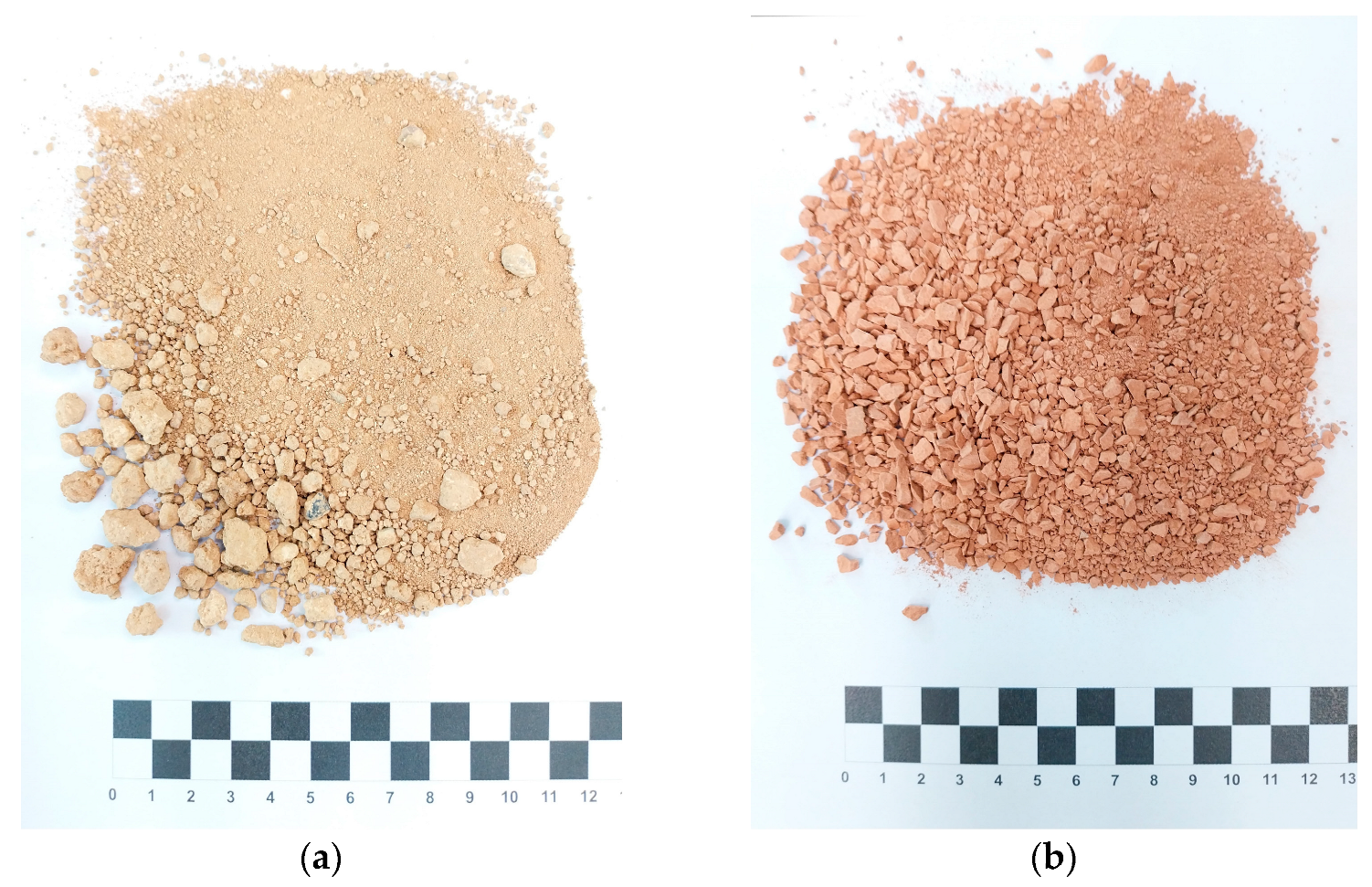

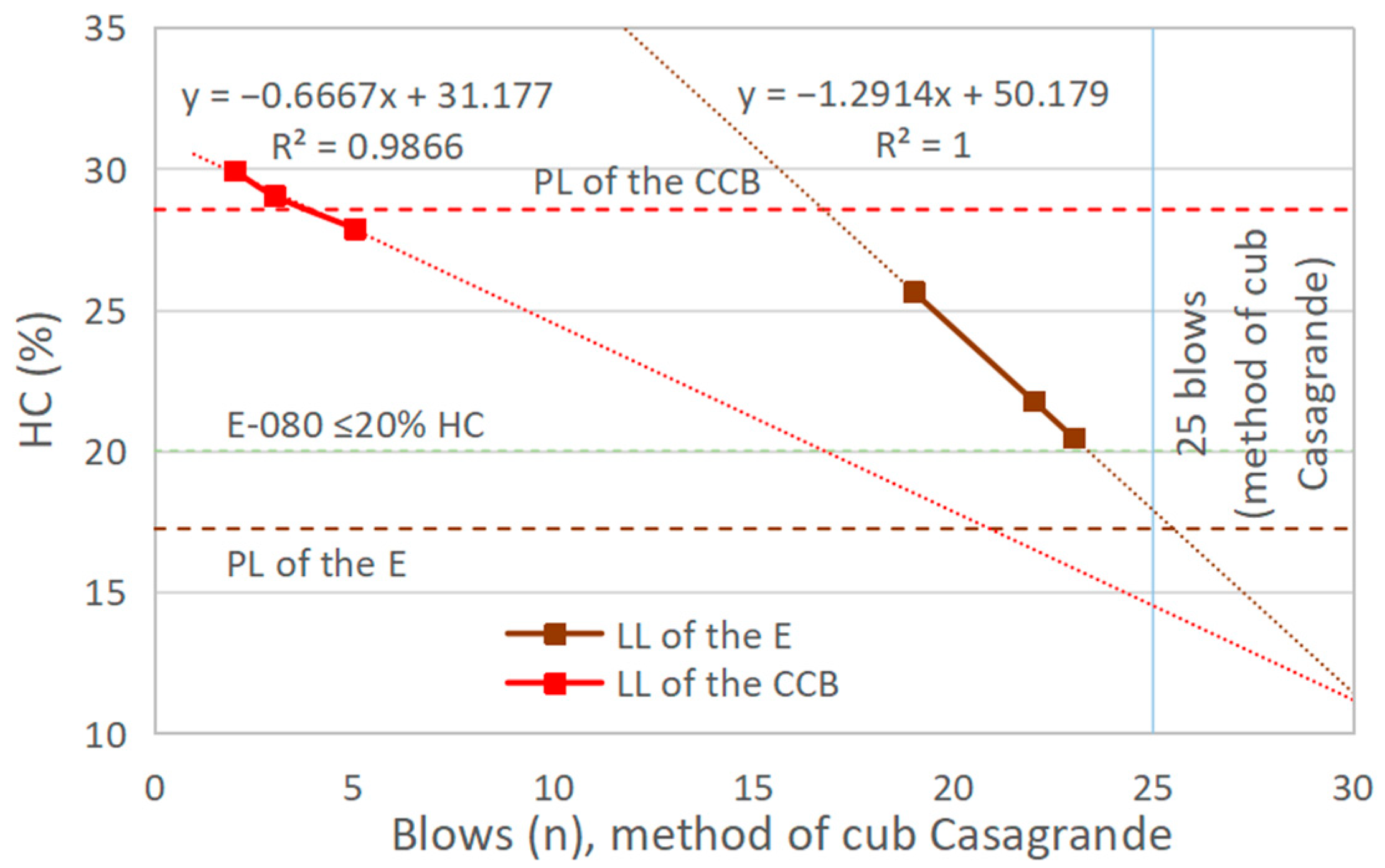

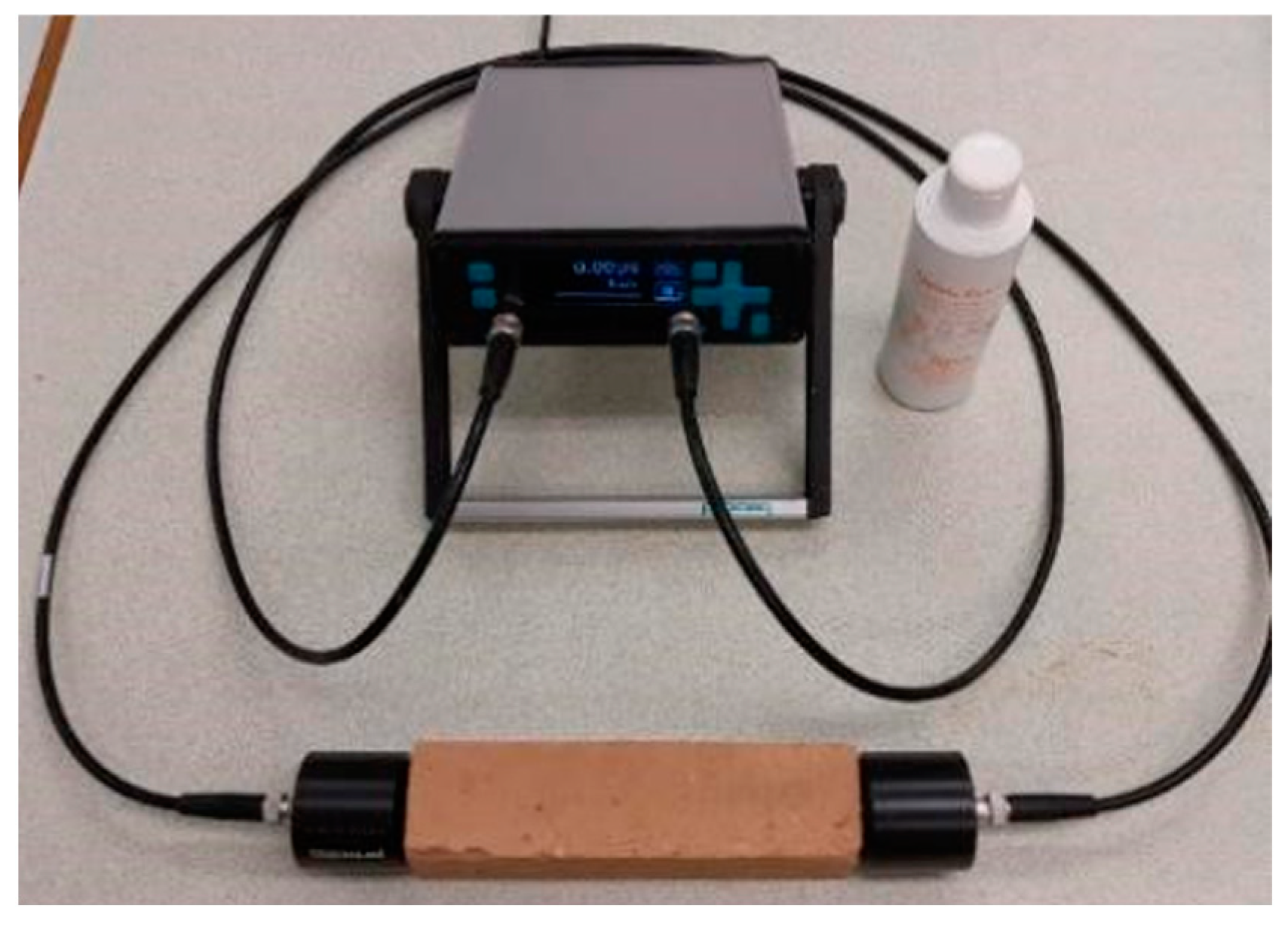

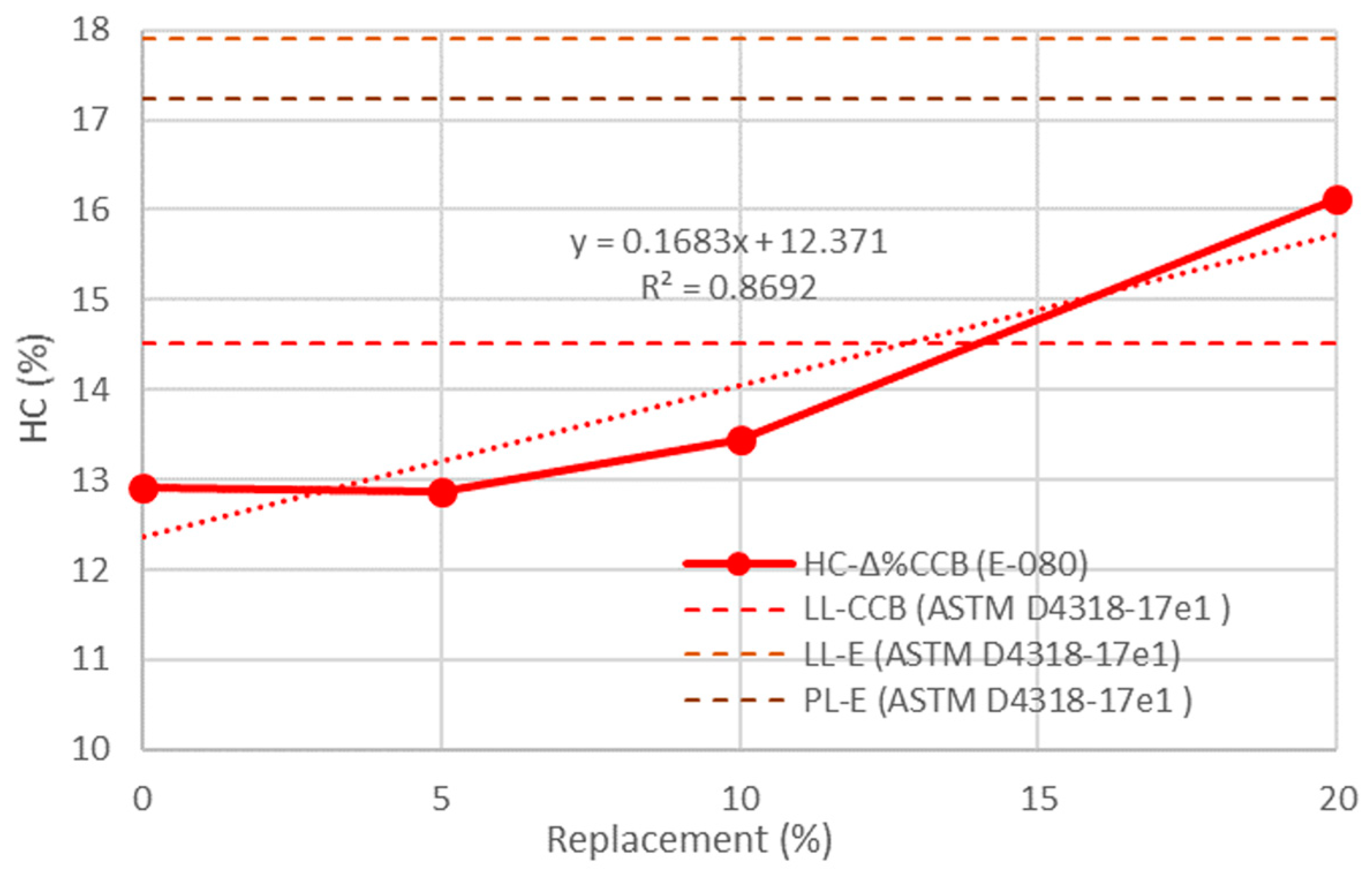
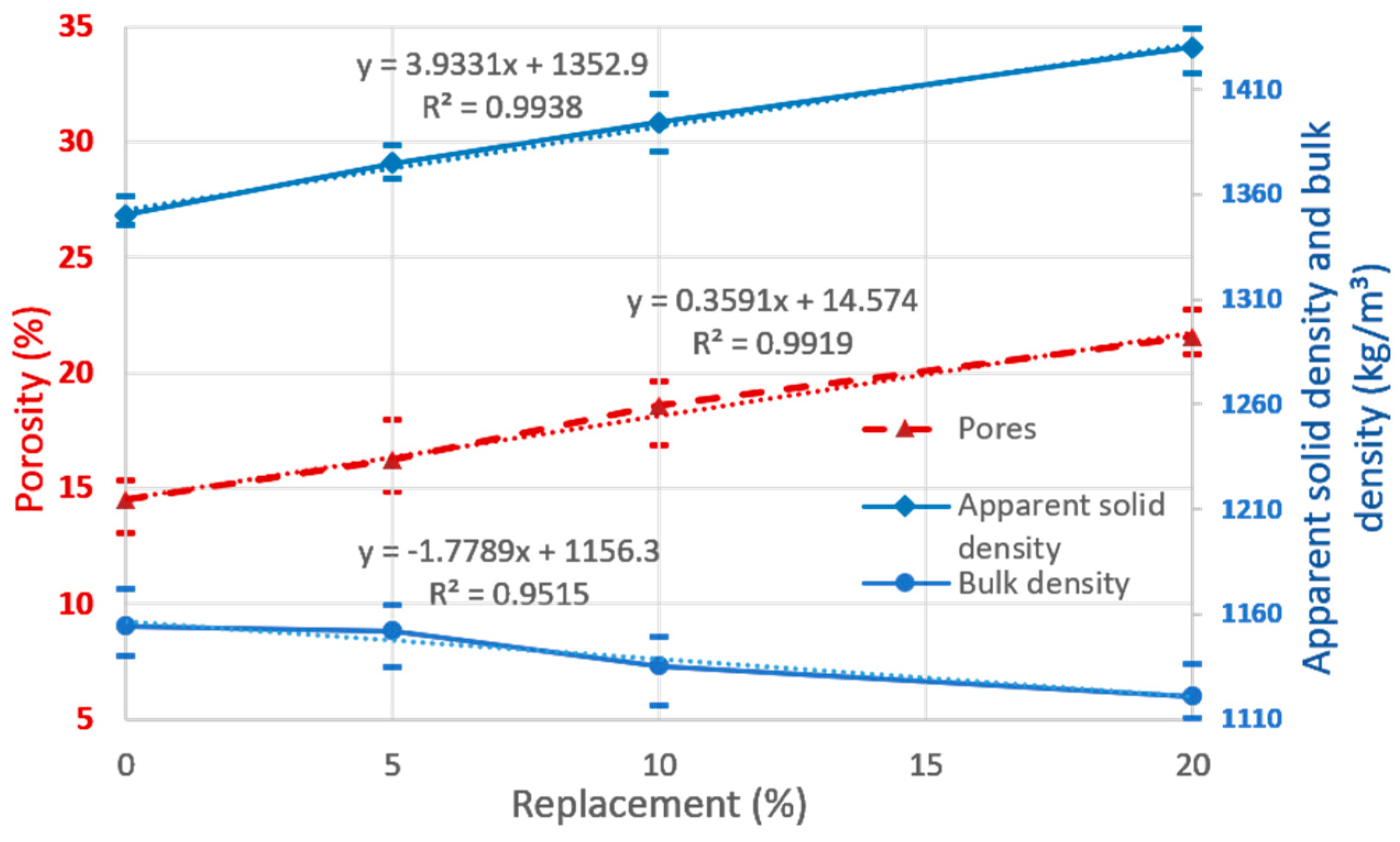
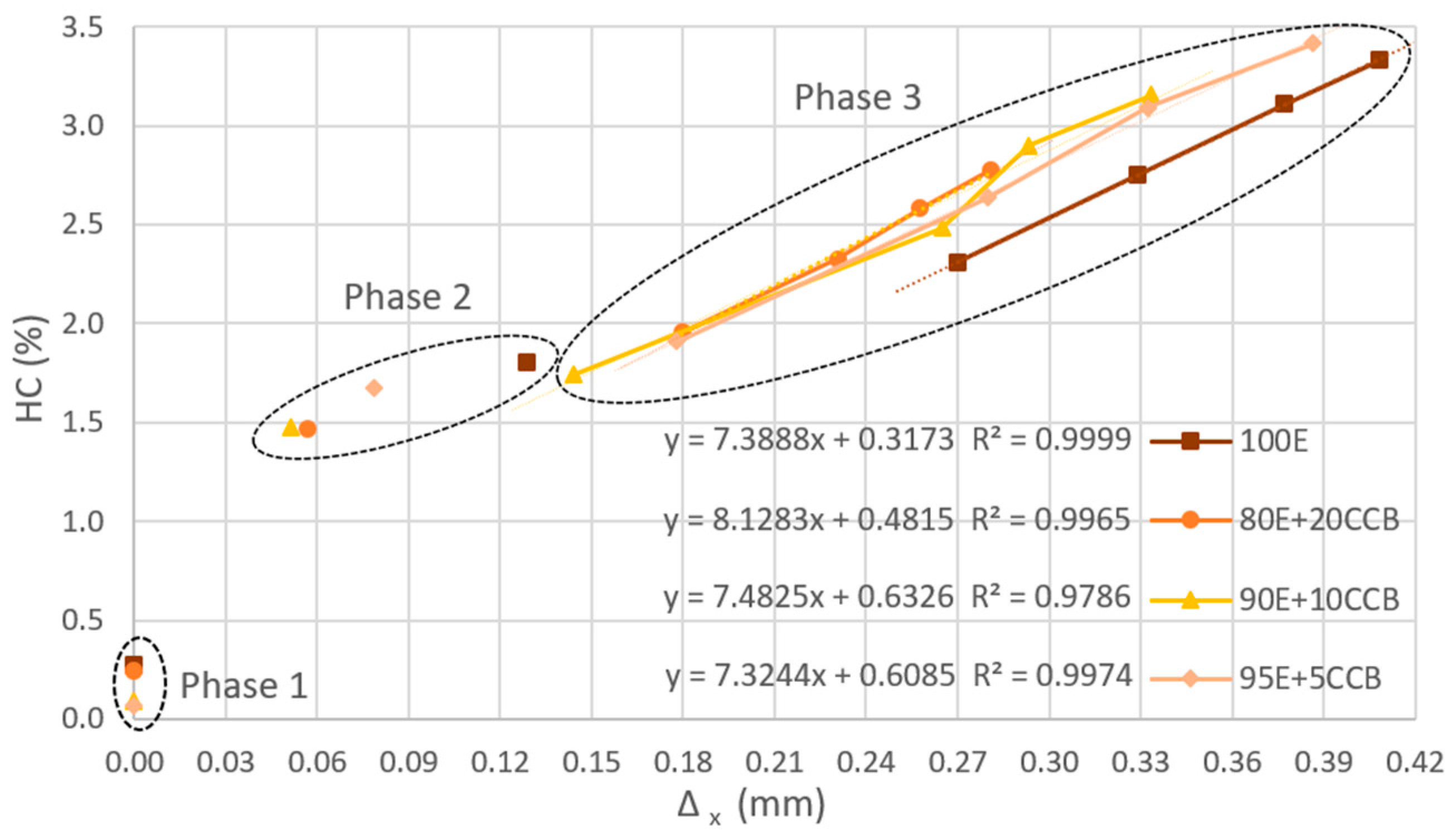
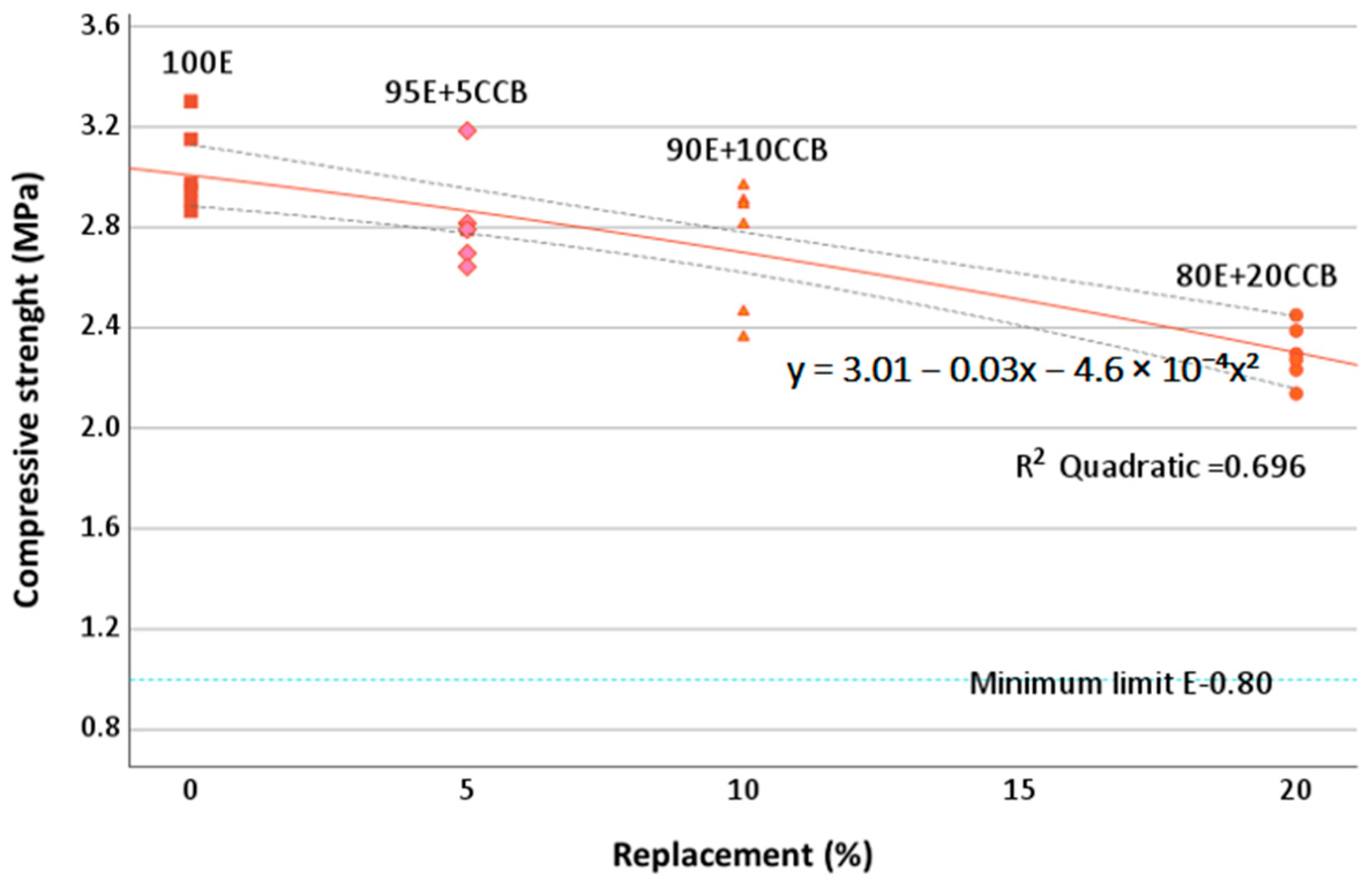


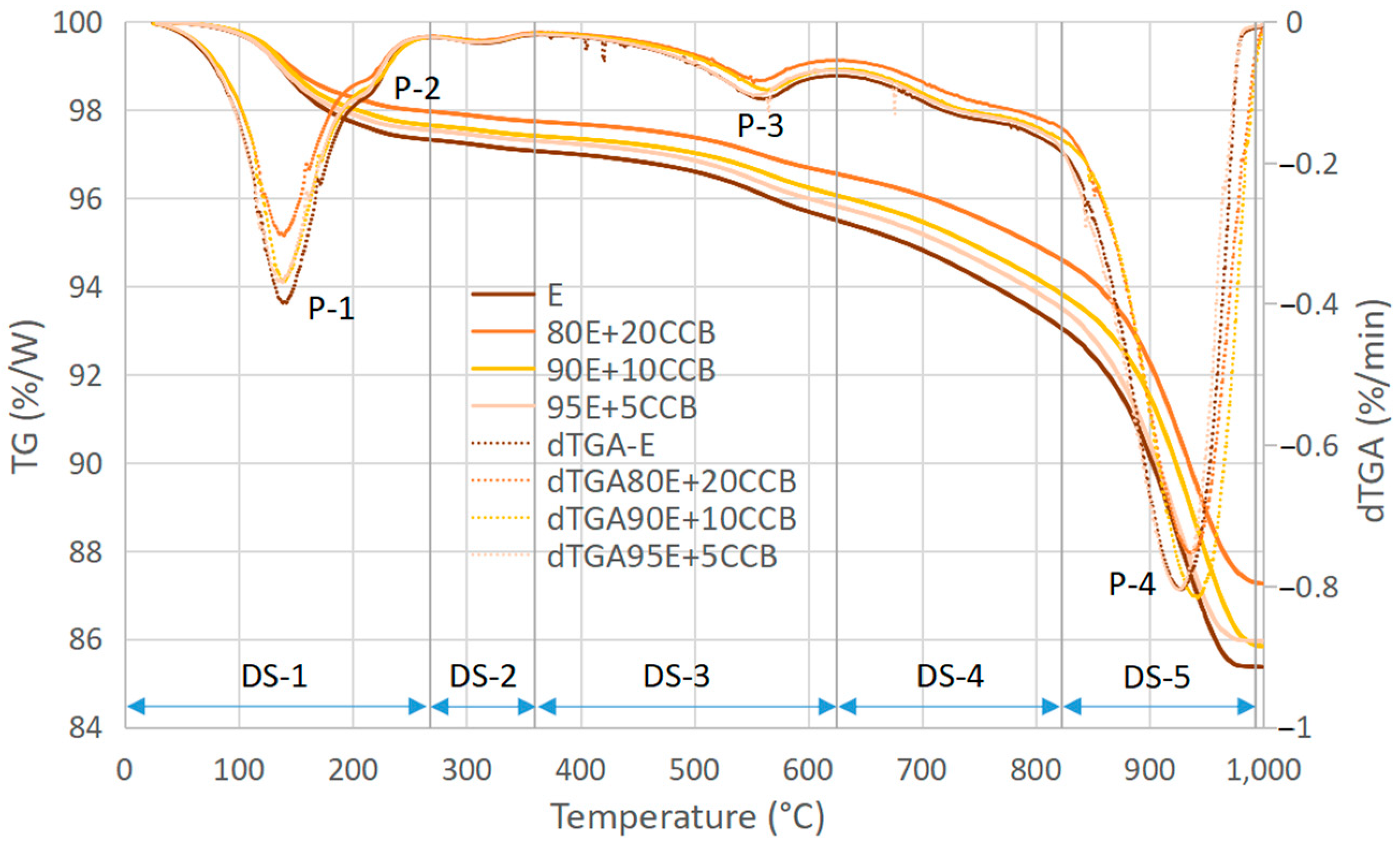


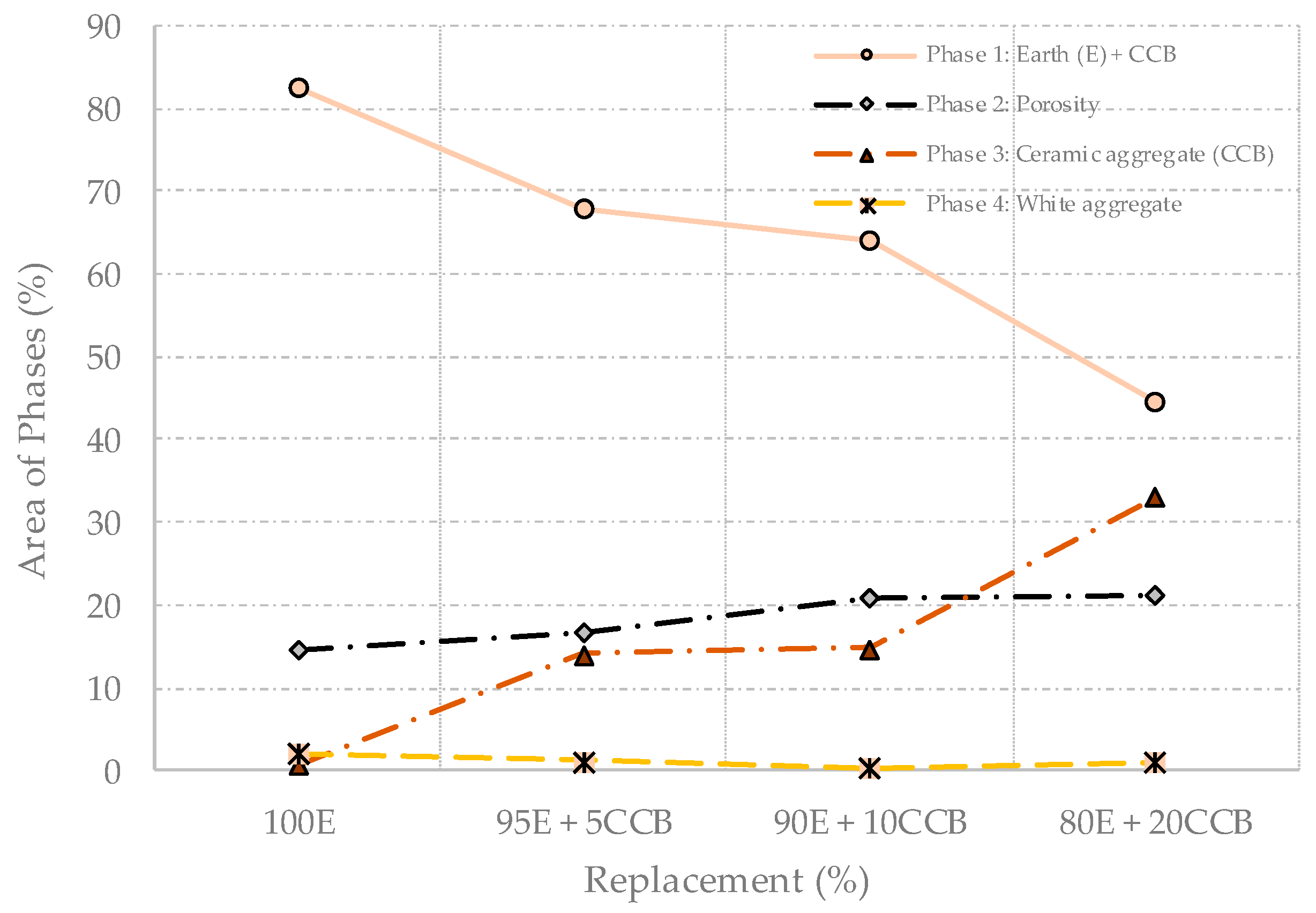
| Physical Properties | E | CCB |
|---|---|---|
| Specific gravity (kg/m3) | 1266.88 | 1120.03 |
| Liquid limit (HC %) | 17.89 | 14.51 |
| Plastic limit (HC %) | 17.24 | 28.55 |
| Moisture Content (HC %) | 3.69 | 0.40 |
| Fineness module | 3.71 | 4.52 |
| Linear shrinkage (%) | 5.33 | - |
| Study Matrix | Replacement of Earth for CCB (%) | E (Kg) | CCB (Kg) | Water (L) |
|---|---|---|---|---|
| 100E | 0 | 1266.88 | 0.00 | 218.41 |
| 95E + 5CCB | 5 | 1203.54 | 56.00 | 227.09 |
| 90E + 10CCB | 10 | 1140.19 | 112.00 | 232.66 |
| 80E + 20CCB | 20 | 1013.50 | 224.01 | 243.54 |
| Nomenclature | Property Studied | Specimen Dimensions (cm) | ||
|---|---|---|---|---|
| Width | Height | Length | ||
| A | Density and porosity, Ultrasonic modulus | 5 | 5 | 10 |
| B | Hygroscopic expansion Ultrasonic modulus | 5 | 5 | 20 |
| C | Simple compression TGA | 10 | 10 | 10 |
| D | Bending strength | 10 | 20 | 40 |
| F | Shrinkage | 5.5 | 1.2 | - |
Disclaimer/Publisher’s Note: The statements, opinions and data contained in all publications are solely those of the individual author(s) and contributor(s) and not of MDPI and/or the editor(s). MDPI and/or the editor(s) disclaim responsibility for any injury to people or property resulting from any ideas, methods, instructions or products referred to in the content. |
© 2025 by the authors. Licensee MDPI, Basel, Switzerland. This article is an open access article distributed under the terms and conditions of the Creative Commons Attribution (CC BY) license (https://creativecommons.org/licenses/by/4.0/).
Share and Cite
Casapino-Espinoza, C.A.; Gómez-Soberón, J.M.; Gómez-Soberón, M.C. The Effect of Recycled Crushed Brick Aggregate on the Physical–Mechanical Properties of Earth Blocks. Buildings 2025, 15, 145. https://doi.org/10.3390/buildings15010145
Casapino-Espinoza CA, Gómez-Soberón JM, Gómez-Soberón MC. The Effect of Recycled Crushed Brick Aggregate on the Physical–Mechanical Properties of Earth Blocks. Buildings. 2025; 15(1):145. https://doi.org/10.3390/buildings15010145
Chicago/Turabian StyleCasapino-Espinoza, Carlos Alberto, José Manuel Gómez-Soberón, and María Consolación Gómez-Soberón. 2025. "The Effect of Recycled Crushed Brick Aggregate on the Physical–Mechanical Properties of Earth Blocks" Buildings 15, no. 1: 145. https://doi.org/10.3390/buildings15010145
APA StyleCasapino-Espinoza, C. A., Gómez-Soberón, J. M., & Gómez-Soberón, M. C. (2025). The Effect of Recycled Crushed Brick Aggregate on the Physical–Mechanical Properties of Earth Blocks. Buildings, 15(1), 145. https://doi.org/10.3390/buildings15010145








